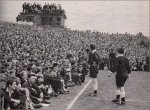Coventry City have been in the top division of the
English League since 1967 and are the fourth longest serving club at that level. In those
30 odd years the club has had its fate decided on the last day of the season on no less
than ten occasions - the most recent in 1996 and 1997.
There were signs in the 1997-98 season however that times are changing at Highfield
Road. Gordon Strachan, in his first full season in charge achieved a minor miracle taking
the club to 11th position in the Premier League and to the quarter finals of
the FA Cup. With Dion Dublin being capped at full level by England and sharing the Golden
Boot for the most Premiership goals scored last season and Darren Huckerby also on the
verge of the full England squad things are looking bright. Added to these two super
strikers the club has aquired two Swedish internationals in Roland Nilsson and goalkeeper
Magnus Hedman.

The club was founded in 1883 by employees of Singers, the cycle firm, and was known as
Singers until 1898 when the name was changed to Coventry City.
Having been members of the Birmingham League since 1894 the club progressed to the
Southern League in 1908 before being elected to Football League Division Two immediately
after the First World War.
Throughout the twenties the club struggled and it was not until the arrival of manager
Harry Storer in 1931 that fortunes improved. The thirties were a golden period for the
Bantams, as the club was then nicknamed. Despite the club being substantially in debt
Storer developed a side which scored 100 goals in four seasons out of five and in 1936 won
promotion to Division Two with average crowds of almost 20,000.
The three seasons prior to the Second World War saw City come close to promotion to
Division One and many observers believed that but for the war City would have acheived
that target.
The post war years were troubled times, Storer left in 1945 and returned in 1951 but
the ageing side were relegated the following year and the fifties saw a slide which
culminated in relegation to Division Four in 1958.
The sixties saw a boom time in Coventry with the car factories keeping pace with the
consumer revolution. The arrival of Jimmy Hill as manager in 1961 sparked start of the Sky
Blue revolution. A new all sky blue kit was unveiled, the nickname was changed, trains
were laid on for fans to travel to away games and pre-match entertainment became
commonplace.

COVENTRY CITY v WOLVES
RECORD CROWDS, 1967
[click photo to enlarge]
|
On the pitch the team delivered. After a feverish Cup run City lost out
in the quarter final to Manchester United but the following season were champions of
Division Three with average crowds of 26,000. Hill, greatly supported by chairman Derrick
Robbins, was the Pied Piper and after three exciting years in Division Two steered the
club to Division One in 1967. That season reached an exhilerating finale in the Midlands
match of the century when nearest rivals Wolves were beaten 3-1 in front of a record
51,455 Highfield Road crowd.
Hill resigned on the eve of the clubs debut in the top flight to enter television. His
successor, Noel Cantwell was left with the task of avoiding relegation with an average
team. He did so and in his third season finished sixth, still their highest ever finish,
to qualify for European football in the Inter Cities Fairs Cup. Cantwell was sacked in
1972 and followed by the Joe Mercer/Gordon Milne double act which produced some exciting
football but lacked consistency.
Hill returned as Managing Director in 1974 but failed to produce his magic a second
time. Finances were poor and the club's best players were sold to balance the books,
although the team of 1977/78 scored 75 goals and played arguably the best football of the
First Division era. Milne was replaced by Dave Sexton in 1981. At the same time the ground
was made all seater - a disastrous mistake which, combined with lack lustre performances
on the pitch, saw average crowds drop to 10,000.
In 1983 Hill resigned as Chairman and Sexton was replaced by Bobby Gould. On the field
the team struggled - relegation being avoided on the last day of the season three years
running. In 1986 Gould's successor Don Mackay was replaced by the duo of George Curtis and
John Sillett who, supported by Coventry born chairman John Poynton, took the club to their
finest hour twelve months later. A team without stars won their way to Wembley through
outstanding teamwork, a gritty determination and above all a sense of fun. They defeated
Tottenham Hotspur 3-2 after extra time in one of the finest post war FA Cup Finals.
After taking sole command after the Cup victory Sillett kept the club in mid table
respectability for three seasons. But the fans wanted more and after two Cup bananaskins
at Sutton and Northampton, Sillett was sacrificed in 1990 and replaced by the former
England captain Terry Butcher. Butcher lasted 14 months. His successor, Don Howe, made way
for the return of Bobby Gould, who resigned after 16 months.
Gould's assistant Phil Neal lasted the same period and was replaced in February 1995 by
the former Manchester United, West Brom and Aston Villa manager Ron Atkinson. Ron
generated much interest and increased gates by 5,000 but despite having substantial funds
at his disposal City always struggled under him. In November 1996, with another relegation
battle looming, he was moved upstairs with his assistant Gordon Strachan taking over as
manager.
The post Wembley years were dogged by poor signings, sales of their best players, a
merry-go-round of managers and empty promises. However since 1993 chairman Bryan
Richardson has worked wonders at the club and his move to bring Atkinson and Strachan to
the city was an inspired one. The club no longer have to sell their best players to
survive and this was shown when Dublin and Huckerby committed themselves to the club by
signing long term contracts in the summer of 1998. Major ground improvements have been
made and attendances have increased by 50% . Plans have been submitted for a new 40,000
plus stadium at Foleshill. If Coventry City fail it will not be through lack of effort.

